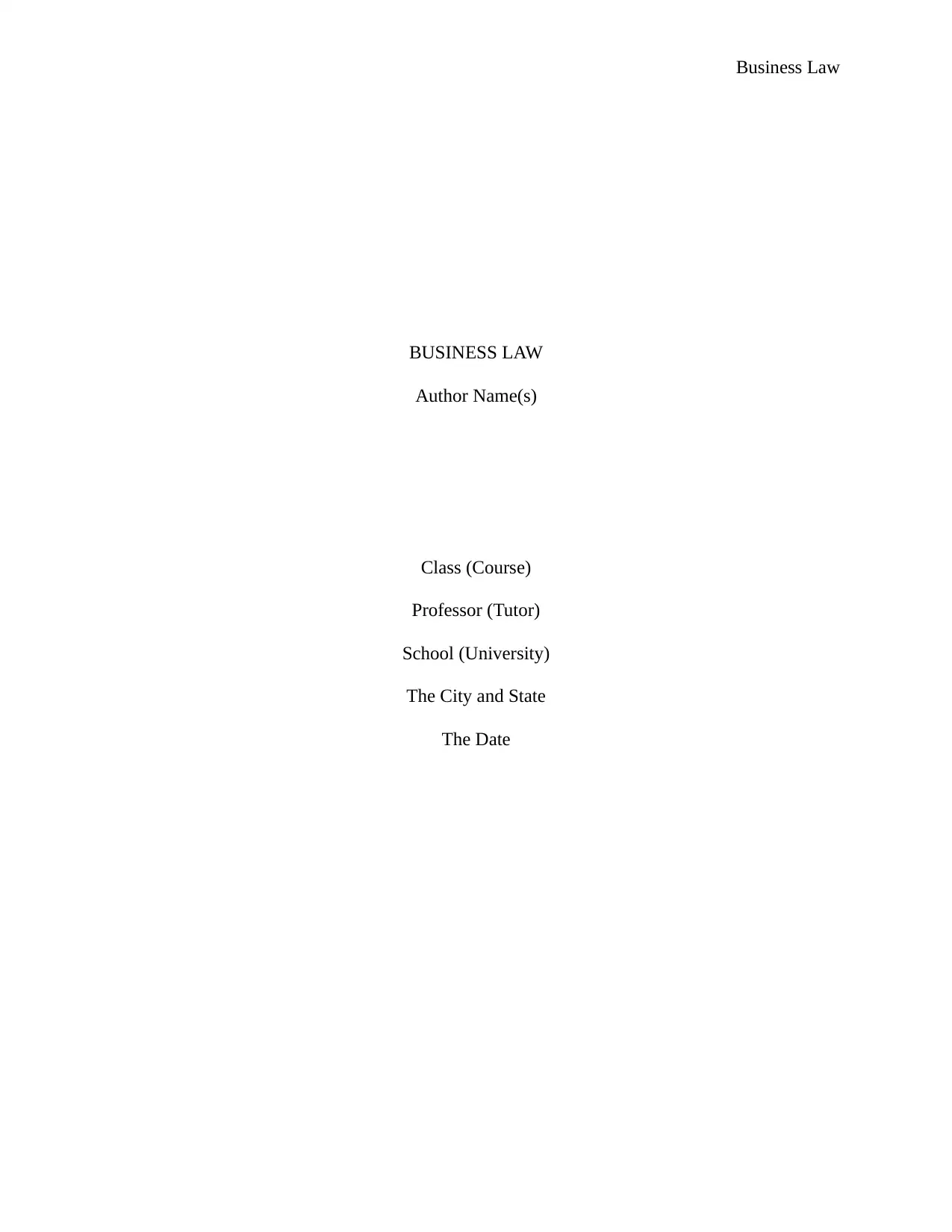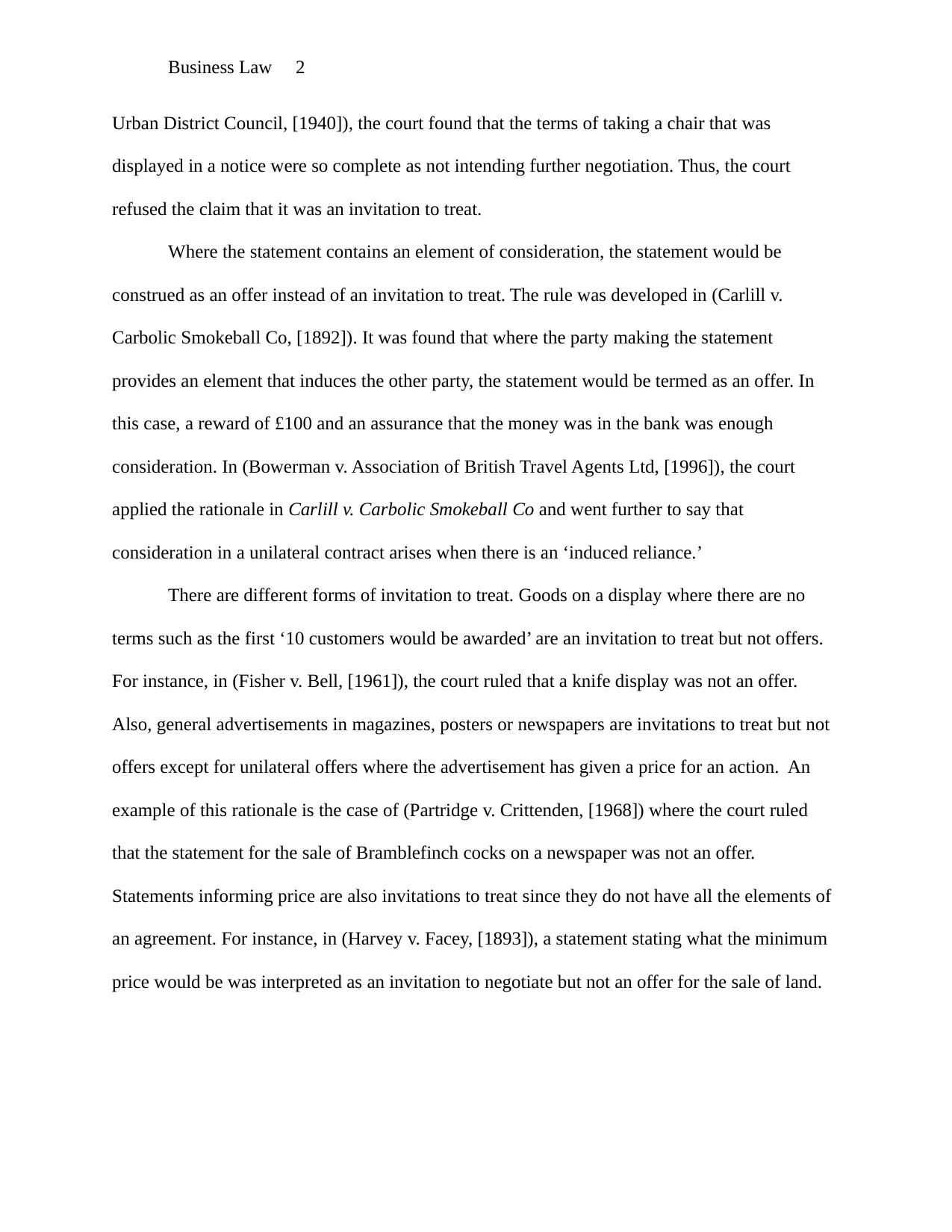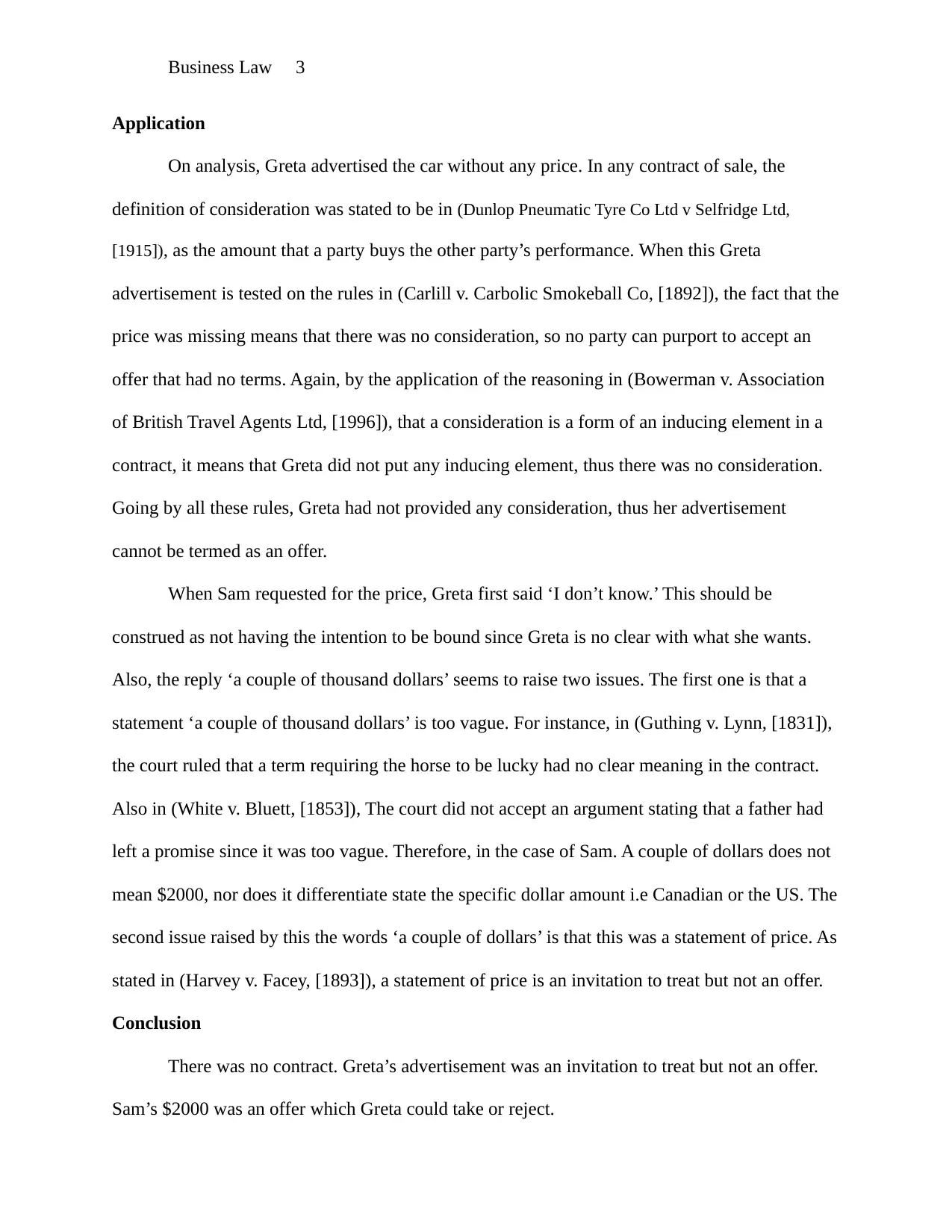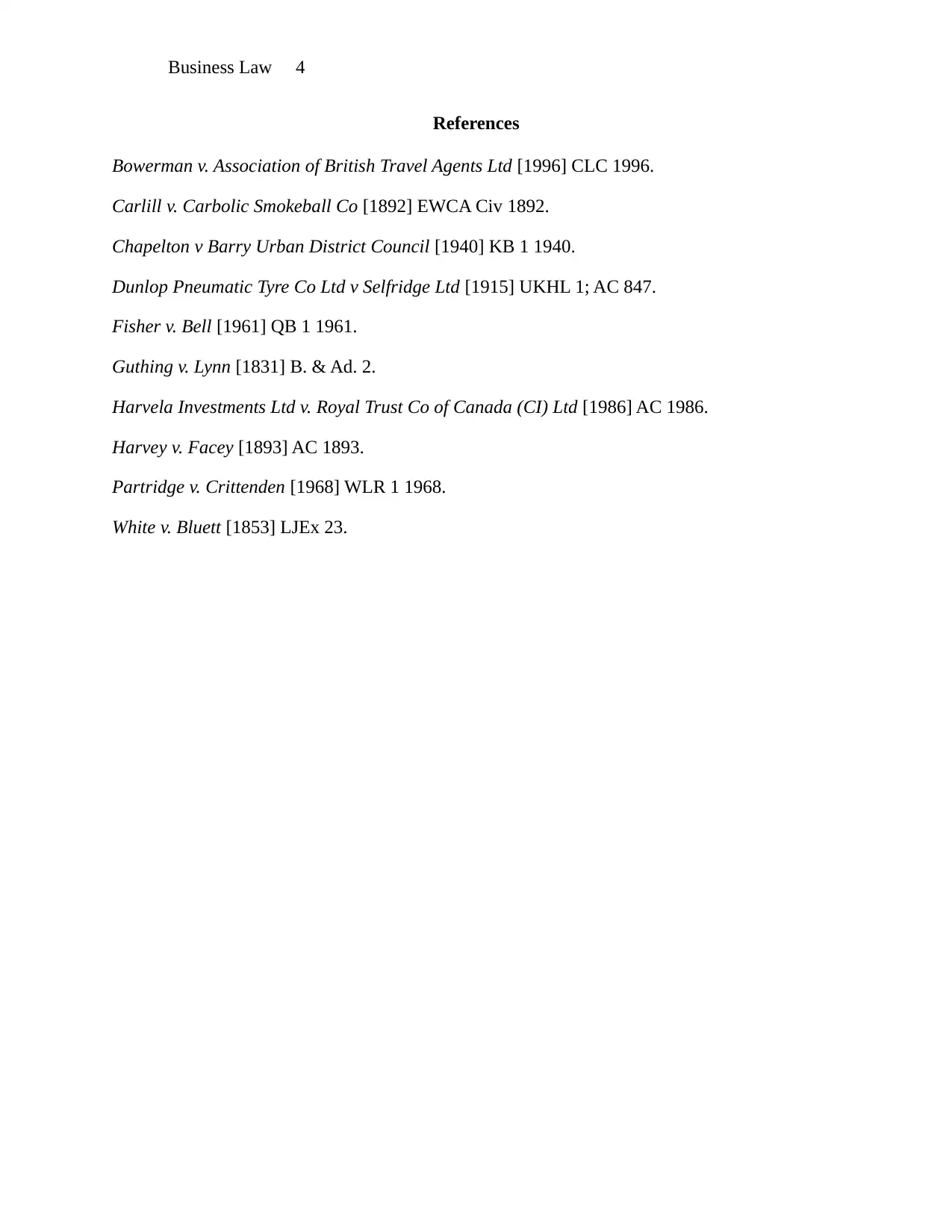Business Law Assignment: Invitation to Treat and Contract Issues
VerifiedAdded on 2023/06/03
|5
|1334
|312
Homework Assignment
AI Summary
This business law assignment analyzes the concept of 'invitation to treat' in contract law, using the scenario of Greta's advertisement for a car and Sam's subsequent inquiries. The assignment examines whether the advertisement constitutes an offer or an invitation to treat, referencing key legal principles and case law such as Carlill v. Carbolic Smokeball Co, Harvela Investments Ltd v. Royal Trust Co of Canada (CI) Ltd, and Harvey v. Facey. It explores the importance of clear terms, consideration, and the intention to create a legally binding relationship. The analysis concludes that Greta's advertisement was an invitation to treat, not an offer, and that no contract was formed between Greta and Sam due to the vagueness of the price and lack of consideration. The assignment highlights the distinction between offers and invitations to treat in various contexts, including advertisements and price statements, and underscores the requirements for a valid contract.

Business Law
BUSINESS LAW
Author Name(s)
Class (Course)
Professor (Tutor)
School (University)
The City and State
The Date
BUSINESS LAW
Author Name(s)
Class (Course)
Professor (Tutor)
School (University)
The City and State
The Date
Paraphrase This Document
Need a fresh take? Get an instant paraphrase of this document with our AI Paraphraser

Business Law 1
Part A: Greto and Sam
Issue
Invitation to treat. Can a statement on an advertisement amount to an enforceable
contract?
Rule
The general rules regarding advertisements are that they should be treated as an invitation
to treat unless proved otherwise. Invitations to treat on their part are not offers, but a call to
someone to come and make an offer. Once the party reading the statement of advertisement
comes and makes the offer, the maker of the statement still retains the rights to accept it or reject
it.
The main difference between an invitation to treat an offer lies in the general rules of an
agreement. That is, an offer should be made by the offeror, and the terms of the offer should be
clear and not ambiguous. An offer should be communicated to the offeree. Acceptance on its part
should be communicated to the offeror, and it should follow the rules of an offer. Lastly, there
should be a consideration, and an intention to create a legally binding relationship.
The landmark case that differentiated between an invitation to treat and offer was the
ruling in (Carlill v. Carbolic Smokeball Co, [1892]). Regarding the terms of an offer, the court
stated that where the terms are clear, complete, and suggest no requirement for further
negotiations, that should be interpreted as an offer but not an invitation to treat. In the case of
(Harvela Investments Ltd v. Royal Trust Co of Canada (CI) Ltd, [1986]), the court stated that
where the words of the party making statement shows its intention to be legally bound, such
statement should be construed to mean an offer as opposed to an invitation to treat. Examples of
these words are such as we bind ourselves, we have a deal. e.t.c. Again in (Chapelton v Barry
Part A: Greto and Sam
Issue
Invitation to treat. Can a statement on an advertisement amount to an enforceable
contract?
Rule
The general rules regarding advertisements are that they should be treated as an invitation
to treat unless proved otherwise. Invitations to treat on their part are not offers, but a call to
someone to come and make an offer. Once the party reading the statement of advertisement
comes and makes the offer, the maker of the statement still retains the rights to accept it or reject
it.
The main difference between an invitation to treat an offer lies in the general rules of an
agreement. That is, an offer should be made by the offeror, and the terms of the offer should be
clear and not ambiguous. An offer should be communicated to the offeree. Acceptance on its part
should be communicated to the offeror, and it should follow the rules of an offer. Lastly, there
should be a consideration, and an intention to create a legally binding relationship.
The landmark case that differentiated between an invitation to treat and offer was the
ruling in (Carlill v. Carbolic Smokeball Co, [1892]). Regarding the terms of an offer, the court
stated that where the terms are clear, complete, and suggest no requirement for further
negotiations, that should be interpreted as an offer but not an invitation to treat. In the case of
(Harvela Investments Ltd v. Royal Trust Co of Canada (CI) Ltd, [1986]), the court stated that
where the words of the party making statement shows its intention to be legally bound, such
statement should be construed to mean an offer as opposed to an invitation to treat. Examples of
these words are such as we bind ourselves, we have a deal. e.t.c. Again in (Chapelton v Barry

Business Law 2
Urban District Council, [1940]), the court found that the terms of taking a chair that was
displayed in a notice were so complete as not intending further negotiation. Thus, the court
refused the claim that it was an invitation to treat.
Where the statement contains an element of consideration, the statement would be
construed as an offer instead of an invitation to treat. The rule was developed in (Carlill v.
Carbolic Smokeball Co, [1892]). It was found that where the party making the statement
provides an element that induces the other party, the statement would be termed as an offer. In
this case, a reward of £100 and an assurance that the money was in the bank was enough
consideration. In (Bowerman v. Association of British Travel Agents Ltd, [1996]), the court
applied the rationale in Carlill v. Carbolic Smokeball Co and went further to say that
consideration in a unilateral contract arises when there is an ‘induced reliance.’
There are different forms of invitation to treat. Goods on a display where there are no
terms such as the first ‘10 customers would be awarded’ are an invitation to treat but not offers.
For instance, in (Fisher v. Bell, [1961]), the court ruled that a knife display was not an offer.
Also, general advertisements in magazines, posters or newspapers are invitations to treat but not
offers except for unilateral offers where the advertisement has given a price for an action. An
example of this rationale is the case of (Partridge v. Crittenden, [1968]) where the court ruled
that the statement for the sale of Bramblefinch cocks on a newspaper was not an offer.
Statements informing price are also invitations to treat since they do not have all the elements of
an agreement. For instance, in (Harvey v. Facey, [1893]), a statement stating what the minimum
price would be was interpreted as an invitation to negotiate but not an offer for the sale of land.
Urban District Council, [1940]), the court found that the terms of taking a chair that was
displayed in a notice were so complete as not intending further negotiation. Thus, the court
refused the claim that it was an invitation to treat.
Where the statement contains an element of consideration, the statement would be
construed as an offer instead of an invitation to treat. The rule was developed in (Carlill v.
Carbolic Smokeball Co, [1892]). It was found that where the party making the statement
provides an element that induces the other party, the statement would be termed as an offer. In
this case, a reward of £100 and an assurance that the money was in the bank was enough
consideration. In (Bowerman v. Association of British Travel Agents Ltd, [1996]), the court
applied the rationale in Carlill v. Carbolic Smokeball Co and went further to say that
consideration in a unilateral contract arises when there is an ‘induced reliance.’
There are different forms of invitation to treat. Goods on a display where there are no
terms such as the first ‘10 customers would be awarded’ are an invitation to treat but not offers.
For instance, in (Fisher v. Bell, [1961]), the court ruled that a knife display was not an offer.
Also, general advertisements in magazines, posters or newspapers are invitations to treat but not
offers except for unilateral offers where the advertisement has given a price for an action. An
example of this rationale is the case of (Partridge v. Crittenden, [1968]) where the court ruled
that the statement for the sale of Bramblefinch cocks on a newspaper was not an offer.
Statements informing price are also invitations to treat since they do not have all the elements of
an agreement. For instance, in (Harvey v. Facey, [1893]), a statement stating what the minimum
price would be was interpreted as an invitation to negotiate but not an offer for the sale of land.
⊘ This is a preview!⊘
Do you want full access?
Subscribe today to unlock all pages.

Trusted by 1+ million students worldwide

Business Law 3
Application
On analysis, Greta advertised the car without any price. In any contract of sale, the
definition of consideration was stated to be in (Dunlop Pneumatic Tyre Co Ltd v Selfridge Ltd,
[1915]), as the amount that a party buys the other party’s performance. When this Greta
advertisement is tested on the rules in (Carlill v. Carbolic Smokeball Co, [1892]), the fact that the
price was missing means that there was no consideration, so no party can purport to accept an
offer that had no terms. Again, by the application of the reasoning in (Bowerman v. Association
of British Travel Agents Ltd, [1996]), that a consideration is a form of an inducing element in a
contract, it means that Greta did not put any inducing element, thus there was no consideration.
Going by all these rules, Greta had not provided any consideration, thus her advertisement
cannot be termed as an offer.
When Sam requested for the price, Greta first said ‘I don’t know.’ This should be
construed as not having the intention to be bound since Greta is no clear with what she wants.
Also, the reply ‘a couple of thousand dollars’ seems to raise two issues. The first one is that a
statement ‘a couple of thousand dollars’ is too vague. For instance, in (Guthing v. Lynn, [1831]),
the court ruled that a term requiring the horse to be lucky had no clear meaning in the contract.
Also in (White v. Bluett, [1853]), The court did not accept an argument stating that a father had
left a promise since it was too vague. Therefore, in the case of Sam. A couple of dollars does not
mean $2000, nor does it differentiate state the specific dollar amount i.e Canadian or the US. The
second issue raised by this the words ‘a couple of dollars’ is that this was a statement of price. As
stated in (Harvey v. Facey, [1893]), a statement of price is an invitation to treat but not an offer.
Conclusion
There was no contract. Greta’s advertisement was an invitation to treat but not an offer.
Sam’s $2000 was an offer which Greta could take or reject.
Application
On analysis, Greta advertised the car without any price. In any contract of sale, the
definition of consideration was stated to be in (Dunlop Pneumatic Tyre Co Ltd v Selfridge Ltd,
[1915]), as the amount that a party buys the other party’s performance. When this Greta
advertisement is tested on the rules in (Carlill v. Carbolic Smokeball Co, [1892]), the fact that the
price was missing means that there was no consideration, so no party can purport to accept an
offer that had no terms. Again, by the application of the reasoning in (Bowerman v. Association
of British Travel Agents Ltd, [1996]), that a consideration is a form of an inducing element in a
contract, it means that Greta did not put any inducing element, thus there was no consideration.
Going by all these rules, Greta had not provided any consideration, thus her advertisement
cannot be termed as an offer.
When Sam requested for the price, Greta first said ‘I don’t know.’ This should be
construed as not having the intention to be bound since Greta is no clear with what she wants.
Also, the reply ‘a couple of thousand dollars’ seems to raise two issues. The first one is that a
statement ‘a couple of thousand dollars’ is too vague. For instance, in (Guthing v. Lynn, [1831]),
the court ruled that a term requiring the horse to be lucky had no clear meaning in the contract.
Also in (White v. Bluett, [1853]), The court did not accept an argument stating that a father had
left a promise since it was too vague. Therefore, in the case of Sam. A couple of dollars does not
mean $2000, nor does it differentiate state the specific dollar amount i.e Canadian or the US. The
second issue raised by this the words ‘a couple of dollars’ is that this was a statement of price. As
stated in (Harvey v. Facey, [1893]), a statement of price is an invitation to treat but not an offer.
Conclusion
There was no contract. Greta’s advertisement was an invitation to treat but not an offer.
Sam’s $2000 was an offer which Greta could take or reject.
Paraphrase This Document
Need a fresh take? Get an instant paraphrase of this document with our AI Paraphraser

Business Law 4
References
Bowerman v. Association of British Travel Agents Ltd [1996] CLC 1996.
Carlill v. Carbolic Smokeball Co [1892] EWCA Civ 1892.
Chapelton v Barry Urban District Council [1940] KB 1 1940.
Dunlop Pneumatic Tyre Co Ltd v Selfridge Ltd [1915] UKHL 1; AC 847.
Fisher v. Bell [1961] QB 1 1961.
Guthing v. Lynn [1831] B. & Ad. 2.
Harvela Investments Ltd v. Royal Trust Co of Canada (CI) Ltd [1986] AC 1986.
Harvey v. Facey [1893] AC 1893.
Partridge v. Crittenden [1968] WLR 1 1968.
White v. Bluett [1853] LJEx 23.
References
Bowerman v. Association of British Travel Agents Ltd [1996] CLC 1996.
Carlill v. Carbolic Smokeball Co [1892] EWCA Civ 1892.
Chapelton v Barry Urban District Council [1940] KB 1 1940.
Dunlop Pneumatic Tyre Co Ltd v Selfridge Ltd [1915] UKHL 1; AC 847.
Fisher v. Bell [1961] QB 1 1961.
Guthing v. Lynn [1831] B. & Ad. 2.
Harvela Investments Ltd v. Royal Trust Co of Canada (CI) Ltd [1986] AC 1986.
Harvey v. Facey [1893] AC 1893.
Partridge v. Crittenden [1968] WLR 1 1968.
White v. Bluett [1853] LJEx 23.
1 out of 5
Related Documents
Your All-in-One AI-Powered Toolkit for Academic Success.
+13062052269
info@desklib.com
Available 24*7 on WhatsApp / Email
![[object Object]](/_next/static/media/star-bottom.7253800d.svg)
Unlock your academic potential
Copyright © 2020–2025 A2Z Services. All Rights Reserved. Developed and managed by ZUCOL.





